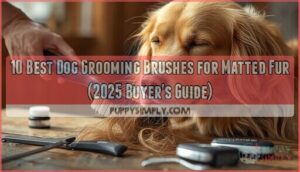This site is supported by our readers. We may earn a commission, at no cost to you, if you purchase through links.
 Beagles’ shedding can turn your home into a fur factory overnight!
Beagles’ shedding can turn your home into a fur factory overnight!
When do beagles shed their puppy coat?
You’ll find that your beagle sheds excessively during their puppyhood and adulthood.
This article will explain the timeline of their shedding patterns, why your beagle sheds so much, and how you can manage the shedding.
Table Of Contents
- Key Takeaways
- Beagle Puppy Coat Timeline
- Beagle Shedding Timeline
- Beagle Shedding Characteristics
- Beagle Shedding Seasons
- Shedding in Beagle Puppies
- Excessive Shedding in Beagles
- Managing Beagle Shedding
- Beagle Shedding in the Home
- Veterinary Care for Beagle Shedding
- Additional Beagle Shedding Information
- Frequently Asked Questions (FAQs)
- How can I differentiate between normal shedding and excessive shedding in beagles?
- What are some common causes of excessive shedding in beagles?
- Can a beagle’s diet impact its shedding?
- Are there any potential health issues associated with excessive shedding in beagles?
- What are some additional tips for managing beagle shedding in the home?
- Conclusion
Key Takeaways
- Beagle puppies’ single coat begins to transition to a double coat at 3 months, leading to increased shedding.
- Beagle shedding settles into a seasonal pattern as they mature, with heavier shedding in the spring and fall.
- Beagles are moderate shedders, shedding more than expected for a short-haired breed due to their double coat.
- Regular brushing and grooming, as well as vacuuming and using lint rollers, can help manage Beagle shedding.
Beagle Puppy Coat Timeline
Your beagle puppy’s coat undergoes a transformation as they grow, influenced by growth stages, shedding triggers, and overall health.
Initially, your puppy will sport a single coat of soft, fluffy fur that sheds minimally.
As your puppy approaches the 3-month mark, their adult coat begins to emerge, heralding a transition to a double coat. This double coat, a hallmark of beagles, consists of a dense undercoat and a coarser outer coat.
The undercoat insulates your beagle, regulating body temperature, while the outer coat repels water and dirt.
During this transition phase, you may notice increased shedding as your puppy’s puppy coat gives way to their adult coat. This shedding is a natural process, and regular brushing can help remove loose hair and promote healthy coat growth.
As your beagle matures, their shedding will typically settle into a seasonal pattern, with heavier shedding occurring in the spring and fall as they adjust to changing temperatures.
Understanding these shedding stages and providing proper grooming care will help you maintain your beagle’s healthy, lustrous coat throughout their life.
Beagle Shedding Timeline
Beagles begin shedding their puppy coats as early as three months of age.
Seasonal shedding occurs twice a year, in spring and winter.
When stressed or experiencing allergies or underlying health issues, beagles may also shed excessively.
Early Shedding
While in their puppy stage, you can expect your Beagle to shed moderately.
This is because they are transitioning from their single puppy coat to their double adult coat.
This early shedding is a natural part of their growth and coat development.
Regular puppy grooming helps manage shedding, keeping your home clean and your Beagle’s coat healthy.
Seasonal Shedding
Beagles shed twice a year, in spring and winter, due to changes in daylight hours and temperature.
These seasonal shedding periods are influenced by environmental factors and affect the beagle’s coat cycle.
Regular brushing and proper care can help manage shedding and maintain a healthy coat.
Stress-induced Shedding
In times of stress, don’t be surprised if your Beagle sheds more than normal.
Stressors like moving, loud noises, or separation anxiety can trigger excessive shedding.
Manage Stress:
Reduce stressors and provide a calm environment.
Health Impact:
Stress-induced shedding can indicate underlying health issues.
Grooming:
Regular brushing helps remove loose hair and promotes healthy skin.
Veterinary Advice:
Consult your vet if shedding persists or worsens.
Underlying Health Issues
Then, you may also notice excessive shedding if your beagle has underlying health conditions.
Refer to this table to understand the possible causes:
| Cause | Symptoms | Treatment |
|---|---|---|
| Hormonal Imbalance | Increased thirst, urination, appetite | Medication, surgery |
| Skin Infections | Redness, swelling, itching | Antibiotics, antifungals |
| Allergies | Itching, sneezing, runny nose | Antihistamines, allergy shots |
Beagle Shedding Characteristics
Beagles are moderate shedders, meaning they shed more than expected for a short-haired breed due to their double coat.
Their shedding is noticeable because their short, coarse, and prickly hair easily embeds in fabrics.
Moderate Shedders
Beagles are moderate shedders, shedding more than expected for short-haired breeds.
Their double coat, consisting of an undercoat and overcoat, contributes to heavier shedding.
You’ll often find yourself removing short, coarse, and prickly hairs embedded in fabrics.
Regular Grooming:
Brush your Beagle regularly to remove dead hair and reduce shedding.
Seasonal Changes:
Beagles shed more during spring and winter due to changes in daylight and temperature.
Health Checks:
Excessive shedding may indicate underlying health issues. Consult a veterinarian if concerned.
Double Coat
Because of your beagle’s double coat, made up of an undercoat and an overcoat, you’ll notice more shedding than expected from its short hair.
This double coat serves as insulation, protecting your beagle from extreme temperatures.
However, it also means more frequent brushing and grooming to keep shedding under control.
Understanding your beagle’s coat and shedding patterns will help you keep your home clean and your beagle healthy.
Noticeable Shedding
While Beagles have a double coat that helps regulate their temperature and protect them from the elements, this coat also contributes to their noticeable shedding.
Their short, coarse, and prickly hair easily embeds in fabrics, making their shedding more apparent despite being moderate shedders.
Regular brushing, deshedding tools, and frequent vacuuming are essential grooming techniques to manage Beagle shedding.
Beagle Shedding Seasons
Beagles experience two distinct shedding seasons: spring and winter.
During spring, they shed their thick winter coat.
In winter, they shed to prepare for the colder months.
These shedding periods are influenced by daylight hours and temperature, rather than age.
Spring
Spring is one of the two main shedding seasons for your beagle, as the thick winter coat falls out.
During this season, your furry companion undergoes a natural process to adapt to changing weather conditions.
Understanding the shedding patterns and seasonal adaptations can help you manage your beagle’s coat transition effectively.
Here are three key aspects to consider:
- Natural Coat Cycle:
- Spring shedding is a part of your beagle’s natural coat cycle, ensuring they have the right coat for the upcoming warmer months.
- Daylight hours and temperature fluctuations play a crucial role in triggering spring shedding, allowing your beagle to regulate body temperature.
- Be aware that artificial lighting and central heating can disrupt your beagle’s natural shedding cycles, potentially leading to year-round shedding.
Winter
During the winter months, you’ll notice an increase in your beagle’s shedding.
The thick winter coat falls out to make way for a lighter summer coat.
This seasonal shedding is a natural process that helps your beagle regulate its body temperature in different climates.
While the shedding may be more noticeable during this time, it’s essential to maintain regular coat care to keep your beagle comfortable and healthy.
Adapt your grooming routines to the seasonal variations, brushing your beagle more frequently to remove loose hair and prevent matting.
Additionally, consider the indoor environment, as central heating can dry out your beagle’s skin and exacerbate shedding.
Adjust your home’s humidity levels and provide ample water to keep your beagle’s skin and coat healthy, reducing excessive shedding.
Shedding in Beagle Puppies
As your Beagle puppy matures, you’ll notice a change in its coat.
Initially, puppies have a single coat of soft fur that sheds minimally.
This coat is gradually replaced by a double coat, consisting of an undercoat and overcoat, which typically occurs between 6 and 12 months of age.
This transition often involves increased shedding as the puppy coat is shed.
Single Coat
Often, beagle puppies sport a single coat of soft fur that sheds minimally, a stark contrast to their adult double coat.
This single coat is a temporary phase, gradually transitioning into the iconic double coat as they mature.
The transition typically takes up to a year, influenced by genetics, nutrition, and environmental factors.
During this transition, shedding patterns may vary, with some puppies experiencing moderate shedding while others shed minimally.
Regular brushing and occasional baths are essential to manage shedding and maintain coat health.
Veterinary consultations can help address any excessive shedding or skin concerns.
Double Coat Development
You’ll notice your beagle puppy’s double coat developing as it matures, usually around 12 months of age.
This transformation brings unique challenges, including increased shedding and the need for more frequent grooming.
Embrace these changes as natural milestones in your beagle’s growth.
Contrary to common myths, double-coated dogs don’t shed more than single-coated breeds.
However, their shedding patterns differ.
Double coats consist of a dense undercoat and a coarser outer coat, resulting in noticeable shedding, especially during seasonal changes.
Equipping yourself with the right grooming essentials is crucial.
Invest in a quality brush designed for double coats and establish a regular brushing routine to remove loose hair and prevent matting.
Seasonal strategies, such as increasing brushing frequency during shedding seasons, will help manage the inevitable shedding.
Excessive Shedding in Beagles
Excessive shedding in beagles may be caused by:
- Stress
- Skin infections
- Skin allergies
Hormonal imbalances, such as thyroid issues, can also lead to unusual hair loss.
Stress
- You’ll notice your beagle shedding excessively if it’s under stress.
Canine anxiety can stem from various sources, like loud noises, separation, or changes in routine.
Implement stress management techniques:
- Provide a calm environment.
- Utilize relaxation techniques.
- Engage in behavioral modification.
- Consider holistic approaches like aromatherapy or herbal remedies.
Skin Infections
Since stress can also lead to skin infections, it’s crucial to monitor for any signs of skin irritation or discomfort in your beagle.
Common causes include:
- Allergies
- Parasites
- Bacterial or fungal infections
Treatment options range from:
- Medicated shampoos
- Antibiotics
- Dietary changes
Preventive measures involve:
- Maintaining good grooming practices
- Seeking veterinary advice promptly if you notice any skin abnormalities
Skin Allergies
Skin allergies can trigger excessive shedding in your Beagle.
Manage allergies through:
- Vet-prescribed medications
- Allergy testing
Regular grooming:
- Removes allergens
- Soothes irritated skin
Feed a limited-ingredient diet to:
- Identify and avoid allergens
Seasonal shedding and stress can exacerbate allergies, so manage these factors too:
- Manage seasonal shedding with desensitization
- Keep home allergen-free
Stress indicators:
- Restlessness
- Panting
- Excessive licking
- Biting
Hormonal Imbalance
Hormonal imbalances can also lead to excessive shedding in your beagle.
Thyroid disorders and adrenal gland deficiencies are common culprits.
Consult your veterinarian for proper diagnosis and treatment.
Managing Beagle Shedding
To manage Beagle shedding:
- Brush your Beagle’s fur regularly to remove dead hair and distribute natural oils.
- Bathe your Beagle every three to four weeks using a mild, natural shampoo to remove dead hair and prevent skin irritation.
- Provide your Beagle with regular physical and mental exercise to promote a healthy coat.
Regular Brushing
Start by brushing your beagle regularly. This removes dead hair, promotes healthy coat growth, distributes natural oils, and prevents mats and tangles.
Grooming Techniques and Coat Care Benefits:
- Regular Brushing:
- Removes dead hair
- Promotes healthy coat growth
- Distributes natural oils
- Prevents mats and tangles
- Effectively removes loose hair during shedding seasons
- Maintains a healthy coat and skin
- Reduces shedding
- Removes dead hair
- Improves skin and coat health
Deshedding Tools
- Employ deshedding tools during shedding seasons to effectively remove loose fur and reduce shedding.
Consider specialized brushes, combs, or rakes designed for double-coated breeds.
Quality Dog Shampoo
You can also use a quality dog shampoo that’s gentle on your beagle’s skin and helps reduce excessive shedding.
This will help maintain coat care, promote skin health, and reduce allergens.
Regular bathing with the right shampoo offers numerous grooming tips and bathing benefits for your beagle.
Bathing
Regularly bathing your beagle with a quality dog shampoo will help remove dead hair and improve skin and coat health.
Cleanse and Nourish:
- Eliminate dirt, debris, and allergens.
- Provide essential nutrients.
Reduce Shedding:
- Remove loose hair.
- Minimize shedding and airborne allergens.
Promote Healthy Skin:
- Soothe irritation.
- Moisturize dry skin.
- Prevent infections.
Enhance Coat Appearance:
- Restore luster, vibrancy, and natural shine.
Regular Physical and Mental Exercise
Providing your beagle with consistent physical and mental stimulation helps maintain a healthy coat.
Exercise benefits your beagle’s overall well-being, reducing stress and promoting behavioral wellness.
Engage your beagle in playful activities and canine enrichment games to stimulate their minds.
Beagle Shedding in the Home
When shedding season arrives or when stressed, your beagle will leave a trail of hair around your home.
Tackle the challenge by:
- Brushing them outdoors.
- Vacuuming and cleaning often.
- Using lint rollers on clothes and furniture.
Brush Beagles Outside
To reduce fur buildup indoors, brush your beagle’s coat outside regularly.
This simple yet effective practice minimizes the amount of loose hair shed inside your home, keeping your living space cleaner and reducing the frequency of indoor cleaning.
Optimize outdoor grooming sessions for maximum fur removal.
Implement seasonal strategies to address shedding variations.
Prioritize fur management techniques for a cleaner home.
Enhance your beagle’s overall well-being through proper grooming.
Vacuum and Clean Regularly
For frequent beagle fur removal indoors:
- Vacuum and clean regularly with a pet-friendly vacuum designed for dog hair.
- Establish a cleaning routine to manage loose fur effectively.
- Vacuum carpets, rugs, and upholstery to prevent fur accumulation and maintain a clean and allergen-free living space.
Lint Rollers
Your beagle’s fur won’t stand a chance against the swipe of a lint roller.
These handy tools capture loose hairs from clothing, furniture, and car seats with ease.
- Keep a lint roller in your car for quick cleanups on the go.
- Use a lint roller to refresh your clothes before leaving the house.
- Keep lint rollers near your furniture to remove fur quickly.
- Use a lint roller to remove fur from your bedsheets and blankets.
Lint rollers are a convenient and effective way to remove beagle hair from various surfaces.
Covers for Furniture
Throw covers over furniture to protect it from beagle fur.
Opt for stylish covers that complement your décor, making cleaning strategies easier.
Decorative throws can also add warmth and texture to your living space while safeguarding your pet-friendly upholstery from beagle fur.
Furniture Protection Strategies:
- Washable Covers: Easy to clean and maintain.
- Slipcovers: Conceal existing upholstery.
- Pet-Friendly Upholstery: Durable and resistant to fur.
Veterinary Care for Beagle Shedding
If you notice excessive shedding in your Beagle, consult a veterinarian to determine the underlying cause and receive appropriate treatment.
A comprehensive examination, including skin and coat evaluation, can help identify potential health issues contributing to the shedding.
Veterinary consultation is crucial, as excessive shedding may indicate underlying medical conditions that require specific treatment.
Veterinary involvement is essential for managing skin infections, allergies, and hormonal imbalances that can trigger excessive shedding.
Your veterinarian can prescribe appropriate medications, recommend specialized shampoos and conditioners, and suggest dietary changes to alleviate skin problems and reduce shedding.
They can also provide guidance on managing stress, a common cause of excessive shedding in Beagles.
Regular checkups with your veterinarian are vital for maintaining your Beagle’s skin health and minimizing shedding.
Routine examinations allow your veterinarian to monitor your dog’s coat and skin condition, identify any potential issues early on, and provide preventive care to keep your Beagle’s coat healthy and lustrous.
Veterinary consultation and adherence to recommended treatment plans are crucial for effectively managing excessive shedding in Beagles.
By working closely with your veterinarian, you can address the underlying causes of shedding, promote skin health, and maintain a healthy, beautiful coat for your beloved companion.
Additional Beagle Shedding Information
Beagles experience shedding throughout their lives.
It can vary among individual dogs.
If you’re concerned about excessive shedding, consult a veterinarian.
Shedding is Normal
One can expect shedding from beagles because it’s a normal part of their coat cycle.
Understanding this natural process is crucial for fostering a healthy relationship with your pet.
Shedding myths can lead to unnecessary anxiety and interventions.
Focus instead on essential grooming practices, including regular brushing, to manage shedding effectively.
Shedding Varies
Observing your beagle’s shedding habits over time will help you recognize any unusual changes that may indicate health issues.
Shedding patterns vary among individual beagles due to factors like:
- Coat development
- Allergy management
- Seasonal influences
- Grooming techniques
Variations in shedding intensity and frequency are normal, but excessive or sudden changes warrant veterinary attention.
Consult a Veterinarian
When you notice excessive shedding in your Beagle, consult your veterinarian to determine the underlying cause.
Veterinary guidance is crucial for managing allergy-related shedding and skin conditions that may contribute to excessive fur loss.
Regular checkups allow your veterinarian to assess your Beagle’s skin health, overall well-being, and provide preventive care advice to minimize shedding concerns.
Consulting a veterinarian ensures proper diagnosis and treatment, promoting your Beagle’s skin and coat health.
Frequently Asked Questions (FAQs)
How can I differentiate between normal shedding and excessive shedding in beagles?
To distinguish normal shedding from excessive shedding in beagles, monitor:
- The frequency of shedding
- The amount of shed fur
- The appearance of shed fur
If shedding:
- Increases suddenly
- Fur loss occurs in clumps
- The skin appears irritated
Consult a veterinarian to rule out underlying health issues.
What are some common causes of excessive shedding in beagles?
Excessive shedding in beagles can result from various causes:
- Stress
- Skin infections
- Allergies
- Unbalanced hormones
- Poor nutrition
Consulting a veterinarian is crucial to determine the underlying cause and receive appropriate treatment.
Can a beagle’s diet impact its shedding?
An appropriate diet, rich in omega fatty acids, can nourish your beagle’s skin and coat, potentially reducing excessive shedding.
Consult your veterinarian for tailored dietary guidance.
Are there any potential health issues associated with excessive shedding in beagles?
Excessive shedding in Beagles may indicate underlying health issues:
- Stress
- Allergies
- Skin infections
- Hormonal imbalances
Consulting a veterinarian promptly is crucial to diagnose and address these conditions effectively, ensuring your Beagle’s well-being.
What are some additional tips for managing beagle shedding in the home?
To effectively manage beagle shedding in your home:
- Employ regular brushing techniques to eliminate loose hair and distribute natural oils throughout their coat.
- Consider using deshedding tools during shedding seasons to further reduce hair buildup.
Conclusion
To what extent does your beagle’s puppy coat shedding affect your lifestyle?
Understanding when your beagle sheds its puppy coat is crucial for managing its shedding.
Regular grooming, a healthy diet, and veterinary care can help reduce excessive shedding.
By following the tips provided in this guide, you can effectively manage your beagle’s shedding, keeping your home clean and your bond with your furry friend strong.
















